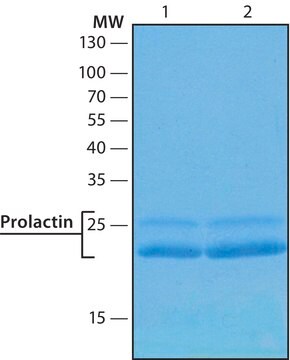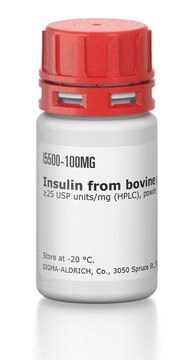L4021
Prolactin human
recombinant, expressed in E. coli, lyophilized powder, BioReagent, suitable for cell culture, >97% (SDS-PAGE)
Synonyme(s) :
hPRL, LTH, Lactogenic Hormone, Luteotropic Hormone, PRL
About This Item
Produits recommandés
Produit recombinant
expressed in E. coli
Niveau de qualité
Description
200 amino acid residue methionyl form of mature, recombinant human prolactin (amino acid residues 29-227).
Gamme de produits
BioReagent
Pureté
>97% (SDS-PAGE)
Forme
lyophilized powder
Puissance
0.030-0.300 ng/mL EC50
Poids mol.
predicted mol wt ~24 kDa
Technique(s)
cell culture | mammalian: suitable
Impuretés
endotoxin, tested
Solubilité
water: 0.5000 mL, clear, colorless
Numéro d'accès UniProt
Conditions d'expédition
ambient
Température de stockage
−20°C
Informations sur le gène
human ... PRL(5617)
Application
Actions biochimiques/physiologiques
Autres remarques
Forme physique
Reconstitution
Remarque sur l'analyse
Mention d'avertissement
Danger
Mentions de danger
Conseils de prudence
Classification des risques
Repr. 1B
Code de la classe de stockage
6.1C - Combustible acute toxic Cat.3 / toxic compounds or compounds which causing chronic effects
Classe de danger pour l'eau (WGK)
WGK 3
Point d'éclair (°F)
Not applicable
Point d'éclair (°C)
Not applicable
Certificats d'analyse (COA)
Recherchez un Certificats d'analyse (COA) en saisissant le numéro de lot du produit. Les numéros de lot figurent sur l'étiquette du produit après les mots "Lot" ou "Batch".
Déjà en possession de ce produit ?
Retrouvez la documentation relative aux produits que vous avez récemment achetés dans la Bibliothèque de documents.
Les clients ont également consulté
Notre équipe de scientifiques dispose d'une expérience dans tous les secteurs de la recherche, notamment en sciences de la vie, science des matériaux, synthèse chimique, chromatographie, analyse et dans de nombreux autres domaines..
Contacter notre Service technique









